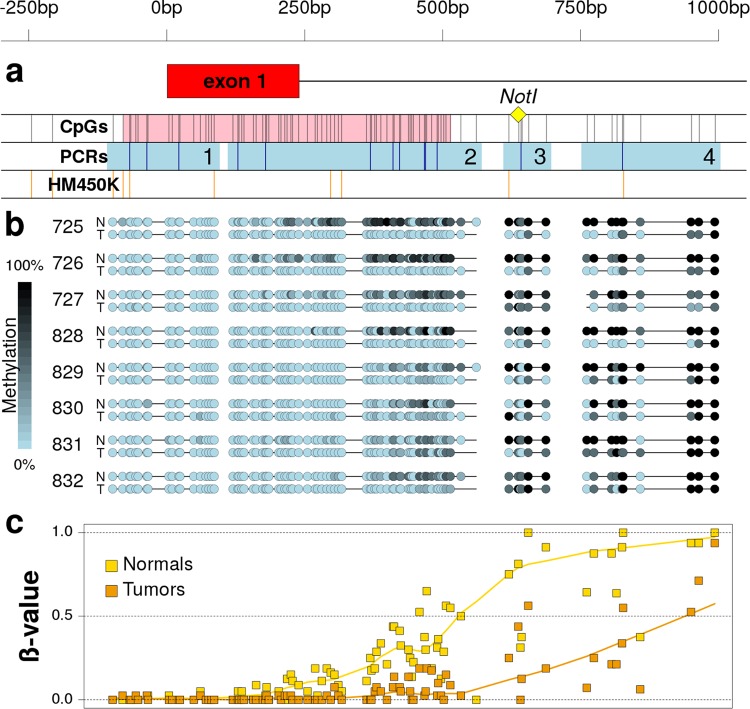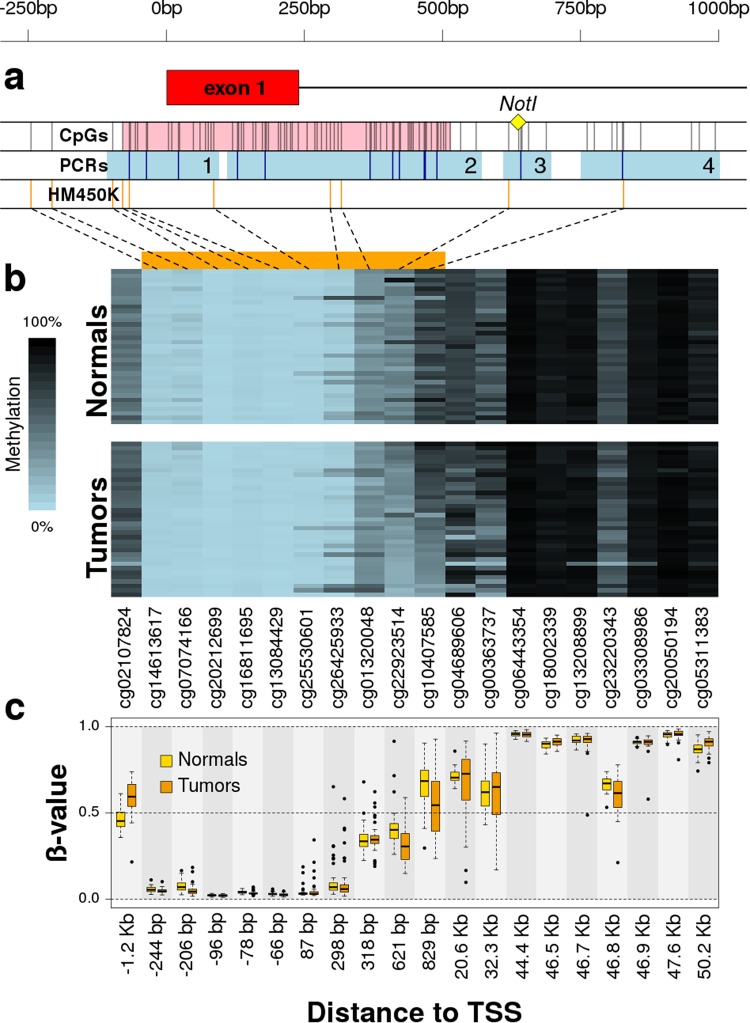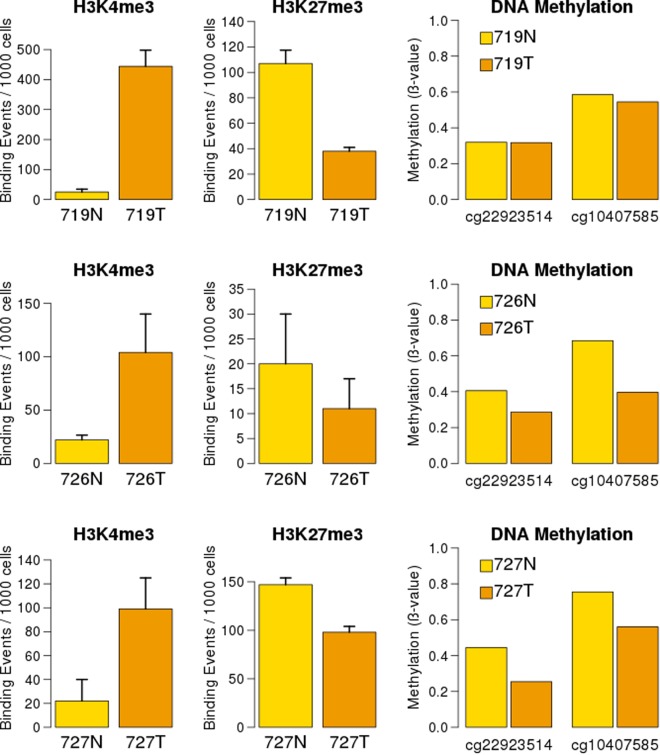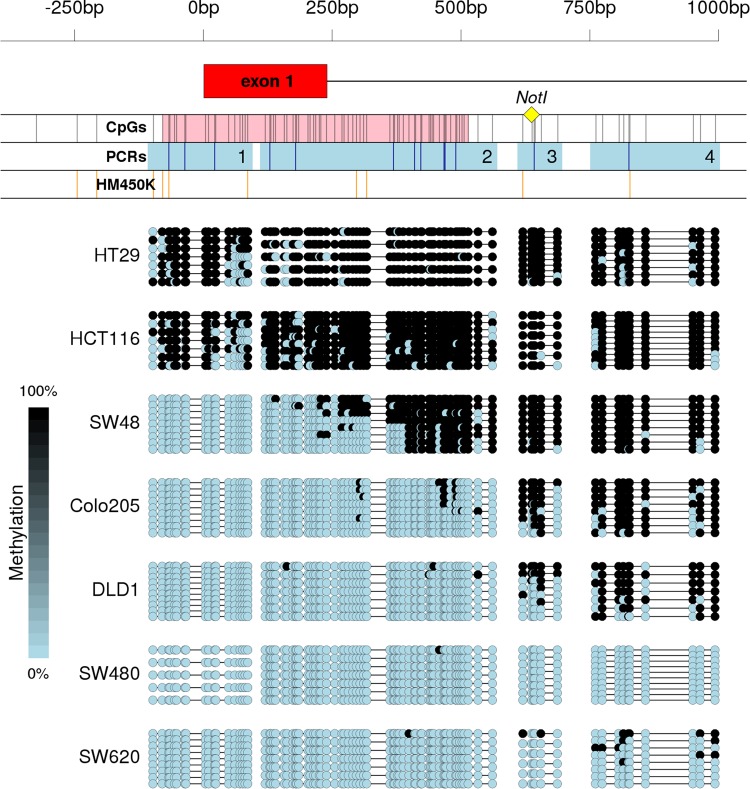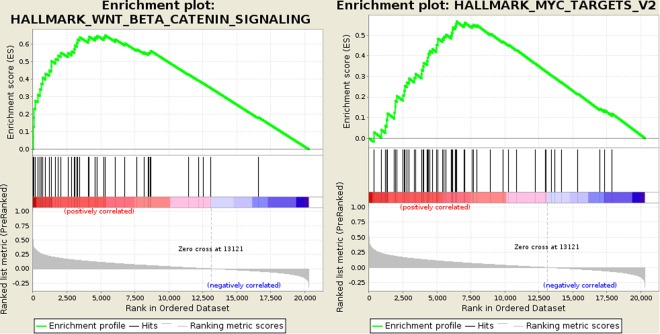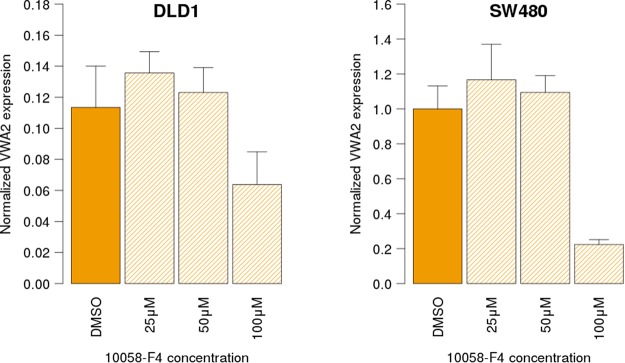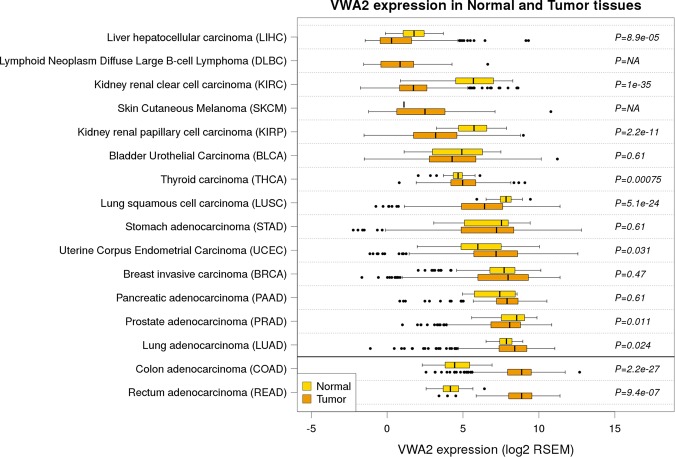Abstract
VWA2 encodes AMACO, a secreted protein up-regulated in most colorectal carcinomas (CRC), constituting a promising biomarker. The mechanism responsible for its aberrant up-regulation has not been previously described. In this work, we analyzed VWA2 DNA methylation in over 400 primary CRCs. No epigenetic alterations were found in its promoter-associated CpG island. However, the region located downstream of the transcriptional start site was hypomethylated in most CRCs. ChIP-Seq revealed increased levels of the active mark H3K4me3 and reduction of the repressive mark H3K27me3. In contrast, several CRC cell lines exhibited hypermethylation of VWA2. 5-AZA-2-deoxycitidine treatment led to transcriptional activation of VWA2, supporting a functional link between DNA methylation and transcription. VWA2 expression in primary CRCs correlated with that of Myc and Myc-target genes. Transcriptional up-regulation of VWA2 is extremely frequent (78%) and strong (average fold change >15) in CRC, but not in other types of cancer. VWA2 undergoes hypomethylation in the majority of CRCs. This alteration could partly underlie the previously reported over-expression of AMACO. Co-expression profiling suggests that VWA2 might be a constituent of a larger oncogenic transcriptional program regulated by c-Myc. Up-regulation of VWA2 is virtually exclusive of CRC, reinforcing its potential as a specific biomarker.
Introduction
The human gene VWA2, located in chromosome 10q25.3, encodes the von Willebrand factor A domain-containing protein 2 (Uniprot Q5GFL6, also known as AMACO)1,2. The primary sequence of AMACO manifests its extracellular localization: a signal peptide at the N-terminus is followed by a VWA domain, a cysteine-rich domain, an epidermal growth factor (EGF)-like domain with fully elongated O-glucosylation and O-fucosylation glycan chains, two more VWA domains, and another EGF-like domain (Fig. S1)2,3.
AMACO is expressed in a variety of cell types, including chondrocytes, keratinocytes and lung and uterine epithelial cells2. Its physiological functions, however, have just begun to be elucidated. Based on its cellular localization and domain structure, it has been postulated that AMACO participates in cell adhesion, migration, homing and signaling following ligand activation through its VWA domains2. AMACO also contains a RGD motif putatively involved in cell adhesion signaling through interaction with integrins4,5.
In a zebrafish study, AMACO was found to be a component of the Fraser complex, involved in the interaction between epithelial cells and the basal membranes. Mutations in FRAS1, FREM2 and GRIP1 genes, other known members of the extracellular Fraser complex, result on the autosomal recessive disorder known as Fraser Syndrome6, albeit no human pathological mutations in VWA2 have been described to date. Double immunoelectron microscopy labeling on P0 mouse skin showed that Fras1 and AMACO co-localized in distinct regions, named anchoring plaques, in the dermis close to the basal membrane. Based on these observations, it has been suggested that the functions of AMACO in tumors somehow mimic its role during development, inducing matrix remodeling and signaling that might promote metastases7.
VWA2 has a very low mutation rate in cancer, and no particular mutation hot-spot has been identified in its sequence according to COSMIC database (http://cancer.sanger.ac.uk/cosmic/gene/analysis?ln=VWA2)8. In colorectal cancer (CRC), a fusion mRNA involving the gene TCF7L2 and exons 1 to 4 of VWA2 has been identified. The reading frame of the parental genes is maintained in the fusion transcript keeping the potential to generate a new fusion protein of undetermined functionality9.
In 2005 AMACO was found to be aberrantly up-regulated in about 80% of human colorectal cancers (CRC), and in the majority of the colonic adenomas. Consequently, this protein was named colorectal cancer secreted protein 2 (CCSP-2)10. Since AMACO is an extracellular-matrix protein that can be secreted into the blood stream, detection of AMACO in plasma was proposed as a candidate serological biomarker of colon neoplasia, and specific immunodetection methods have been developed based on AMACO overexpression11.
Despite the putative interest of AMACO as a CRC biomarker, very little is known about the mechanism leading to its deregulation in colon cancer cells. In 2006 we reported the comprehensive analysis of DNA methylation alterations in a series of 149 gastrointestinal tumors using methylation sensitive amplified fragment length polymorphism (MS-AFLP), a fingerprinting technique to identify somatic changes in methylation at randomly selected NotI sites (5′GCGGCCGC3′) throughout the genome12–14. Using that technique, we identified a Not site undergoing somatic hypomethylation in around 15% of the colorectal cancers (CRC) and around 8% of the gastric cancers (GC). In this work, we further explored that initial observation, we mapped the frequently altered NotI site within the intronic region 635 bp downstream of the canonical transcriptional start site (TSS) of VWA2 gene, and characterized in much higher detail the incidence, extension, and functional consequences of somatic DNA hypomethylation of VWA2 in both primary CRC samples and cell lines. We also performed a comparative analysis of VWA2 overexpression in 36 different types of cancer, exploring the data from the The Cancer Genome Atlas (TCGA).
Results
The first intron of VWA2 is hypomethylated in primary colorectal cancers
In a previous study, we employed MS-AFLP to profile somatic methylation alterations in 64 colorectal cancers and 85 gastric cancers, revealing the existence of a hypomethylated genomic locus corresponding to an electrophoretic band named C-4613. That band was excised from a MS-AFLP gel, re-amplified by PCR using the NotI and Mse + C primers (Supplementary Table ST1), and sequenced. The resultant sequence mapped at a NotI site located 637 bp downstream of the transcriptional start site (TSS) of the gene VWA2, outside the CpG island (CGI) that completely covers its first exon (Fig. 1a).
Figure 1.
Methylation of the 5′-associated region of VWA2 in normal and tumor tissues of CRC patients. The scale on top is valid for the three panels and refers to the distance (in bp) to the VWA2 transcriptional start site. Panel a: Scheme of the DNA region containing the first exon of VWA2 (exon 1, in red). The yellow diamond indicates the location of the NotI site originally found hypomethylated by the MS-AFLP analyses. The first track (CpGs) shows the CpG sites (black vertical bars) and the promoter-associated CpG island (in pink). The second track (PCRs) shows the four products analyzed by bisulfite-based PCR (light blue squares) and the BstUI sites studied by COBRA (dark blue vertical bars). The third track (HM450K) indicates the position of the 10 probes of the Illumina HM450K methylation arrays within this region. Panel b: methylation status in normal (N) and tumor (T) tissues from CRC patients 725, 726, 727, 828, 829, 830, 831 and 832. Methylation was estimated by direct Sanger’s sequencing of the four PCR products shown in panel a. Panel c: average methylation level of normal (yellow) and tumor (orange) tissues from the eight patients shown in panel b, at every CpG site within the studied region. The solid lines represent the locally weighted moving average.
We extended the number of CRC cases analyzed by MS-AFLP to a total of 81. The NotI site was considered to be somatically hypomethylated in 14 cases (17%, scoring methodology detailed in methods). No significant association was found between somatic hypomethylation of this NotI site and patient gender, race, tumor location, MSI phenotype or the presence of mutations in TP53, KRAS or BRAF. We found, however, a positive association with patient age (P = 0.007, Student’s t-test, Table 1). This association retained statistical significance in multifactorial logistic regression analysis including age, gender, race, tumor location, MSI status and mutations in TP53, KRAS and BRAF as explanatory factors (OR = 1.12 per year, CI = 1.04–1.23, P = 0.005, Supplementary Table ST2).
Table 1.
Clinico-pathological characteristics of 81 CRC cases classified according to VWA2 methylation analyzed by MS-AFLP.
| No Somatic Hypomethylation | Somatic Hypomethylation | P-value | ||
|---|---|---|---|---|
| Total | 67 (83%) | 14 (17%) | ||
| Gender | Female | 30 (79%) | 8 (21%) | 0.56 |
| Male | 37 (86%) | 6 (14%) | ||
| Race | Caucasian | 40 (83%) | 8 (17%) | 0.76 |
| African Amer. | 21 (81%) | 5 (19%) | ||
| Age | 63.6 ± 10.7 | 74.3 ± 12.1 | 0.007 | |
| Tumor | Proximal | 38 (84%) | 7 (16%) | 0.57 |
| Location | Distal | 27 (79%) | 7 (21%) | |
| MSI status | MSS | 58 (83%) | 12 (17%) | 1.0 |
| MSI | 8 (80%) | 2 (2%) | ||
| TP53 | Wild Type | 31 (84%) | 6 (16%) | 1.0 |
| Mutant | 29 (85%) | 5 (15%) | ||
| KRAS | Wild Type | 40 (87%) | 6 (13%) | 0.52 |
| Mutant | 22 (81%) | 5 (19%) | ||
| BRAF | Wild Type | 50 (85%) | 9 (15%) | 0.61 |
| Mutant | 6 (75%) | 2 (25%) | ||
In parentheses, the percentage of cases without or with somatic hypomethylation within each studied group (in rows). P-values were calculated by Fisher’s exact test except for patient age, where Student’s t-test was applied. In bold, P-values < 0.01.
We analyzed the CpG methylation levels around the TSS of VWA2 by bisulfite direct-PCR sequencing in a subset of colorectal cancer samples. The analyzed sequence comprised its first exon, the associated CpG island and the north and south CpG island shores (Fig. 1b). Since this region was too long for a single bisulfite-PCR reaction (1.1 Kb, encompassing 89 CpG sites), the analyses were performed in 4 separate PCRs (regions 1 to 4, Fig. 1a). No substantial somatic differences in methylation were found in the first exon or the area close to the TSS, that were essentially unmethylated in both normal and tumor tissues. Downstream of the first exon, however, the difference in methylation between normal and tumor samples gradually increased along the south shore of the CGI, were the MS-AFLP-detected NotI site was located (Fig. 1b,c). BstUI-based combined bisulfite and restriction analyses (COBRA)15 of these four regions was employed to further validate these observations in the samples previously analyzed by MS-AFLP. No clear changes in the COBRA electrophoretic profiles between normal and tumor tissues were found in PCR regions 1 and 2. COBRA detected somatic changes in methylation in region 3, although in some samples the results were difficult to interpret due to the intermediate levels of methylation in both normal and tumor tissues (not shown). The PCR to analyze the region 4 was 315 bp containing a single BstUI site (Fig. 1a), and clearly confirmed the hypomethylation of this region in tumors (Supplementary Fig. S2).
We profiled the methylation of this region in 35 primary tumors and their matched normal samples using Illumina HM450K methylation arrays. These arrays contain 22 probes within the VWA2 locus ±1.5Kb, eight of them overlapping the region previously studied by PCR (Fig. 2a). Two probes were excluded during the computational preprocessing step: probe cg24882714 because it overlaps with SNP rs56041166 (MAF = 8% in European populations), and probe cg24242022 which was removed by the Greedycut algorithm that controls the reliability of the methylation call16. For the remaining 20 probes, we calculated the average methylation difference in ß-units between tumor and normal samples (∆ß, Supplementary Table ST3). In agreement with the bisulfite sequencing and COBRA results, the Illumina HM450K analysis showed very small methylation differences between normal and tumor tissues (∆ß < 0.02) within the CGI that overlaps the TSS and first exon, albeit some of them reached statistical significance (P < 0.01 paired t-test). Probes cg22923514 (region 3, ∆ß = −0.096, P = 1.97 × 10−4) and cg10407585 (region 4, ∆ß = −0.129, P = 4.16 × 10−3) were clearly hypomethylated in tumors compared to normals (Fig. 2b,c), with a strong correlation between them (r = 0.64, P = 2.97 × 10−5). That correlation, together with their physical proximity (~200 bp), suggested that they signal the same somatic hypomethylation event taking place at the south shore of the VWA2 CGI. Probe cg02107824, located 1.2Kb upstream of the TSS and outside of the region previously analyzed by PCR, exhibited somatic hypermethylation (∆ß = 0.123, P = 1.09 × 10−7). We also found statistically significant somatic methylation changes in another three probes (cg18002339, cg23220343 and cg05311383) located much farther from the TSS, in the +46 to +50 Kb downstream region.
Figure 2.
Methylation of VWA2 locus in 35 pairs of matched normal and tumor tissues from CRC patients. Panel a: Scheme of the 5′-associated region of VWA2. Symbols and tracks like in Fig. 1. Panel b: methylation heatmap of the Illumina HM450K array probes within the VWA2 locus in normal and tumor tissues from 35 CRC patients. Methylation is represented in a blue to black gradient. The horizontal orange bar on top of the heatmap indicates those probes within the 5′-associated region shown in panel a. Patients are ordered in the vertical axis according to the average methylation of probes cg22923514 and cg10407585 in tumors. Probes are ordered in the horizontal axis according to their location in the genome. Panel c: boxplot of the ß-values of these probes in normal (yellow) and tumor (orange) tissues from the 35 patients shown in panel b. The distance to the transcriptional start site (TSS) of every probe is indicated in the x-axis.
Somatic methylation changes of the VWA2 locus were additionally validated using the publicly available data from colon (COAD) and rectal (READ) cancer datasets from The Cancer Genome Atlas (TCGA)17. In total, 352 CRC samples and 45 normal colonic mucosa samples with methylation information were available, derived from 350 CRC patients (tumor samples from two patients were analyzed in duplicate, from two separate vials each). The TCGA methylation analysis pipeline excluded cg20212699 in all samples, and cg02107824 was excluded in COAD samples (Supplementary Fig. S3). This larger dataset confirmed our original observations: very small somatic methylation changes in the VWA2 CpG island except for the probes in the region 3 (cg22923514) and 4 (cg10407585), that were significantly hypomethylated in tumors (P = 5.5 × 10−6 and P = 4.4 × 10−6, respectively). Exactly as previously observed in our tumor collection, the methylation levels reported by these two probes in the TCGA data exhibited a strong intercorrelation (r = 0.68, P = 2.7 × 10−48), once again suggesting that they both signal the same demethylation event. The probe cg02107824, located 1.2Kb upstream of the TSS, was clearly hypermethylated in TCGA tumors, also in agreement with our previous results. Other probes located in the gene body, over 20Kb downstream of the TSS, exhibited also statistically significant somatic methylation changes (Supplementary Table ST3).
VWA2 undergoes epigenetic remodeling in CRC
Somatic changes in histone marks in the VWA2 region were analyzed by chromatin immunoprecipitation using formalin-fixed paraffin-embedded (FFPE) normal and tumor samples from three CRC patients previously analyzed by Illumina methylation arrays. Case 719 did not exhibit somatic changes in DNA methylation in the VWA2 CGI south shore (probes cg22923514 and cg10407585), while cases 726 and 727 showed somatic hypomethylation of this region.
The results revealed a significant increase of histone mark H3K4me3 and decrease of H3K27me3 in the 5′ region of VWA2, consistent with an epigenetic remodeling from transcriptionally inactive to transcriptionally active chromatin (Fig. 3). Notably, epigenetic remodeling was observed in the three studied cases, including case 719 that was not somatically hypomethylated according to the Illumina HM450K array analysis.
Figure 3.
Histone marks and DNA methylation in the VWA2 promoter region of normal (N, in yellow) and tumor (T, in orange) tissues from CRC patients 719, 726 and 727. Two different histone modifications, i.e. H3K4me3 and H3K27me3, were analyzed by FFPE ChIP-Seq. These three cases exhibited a significant increase in the active-chromatin mark H3K4me3 (left) and a significant decrease in the repressive-chromatin mark H3K27me3 (middle). Methylation values of Illumina HM450K array probes cg22923514 and cg10407585, located in the VWA2 CGI south shore, are shown (right). Case 719 did not exhibit clear changes in methylation. Cases 726 and 727 exhibited somatic hypomethylation at both probes.
Hypomethylation of VWA2 correlates with mRNA expression in primary cancers
The TCGA COAD and READ datasets were employed to study the association between VWA2 methylation and transcriptional expression. Transcriptional expression (RNAseq) data from 594 CRC samples was obtained from the release 20 of the International Cancer Genome Consortium (ICGC). These samples derived from 581 patients (in thirteen of them, 2 different sections of the tumor were analyzed). For the VWA2 methylation-expression association analysis, we employed 348 samples that have both VWA2 methylation and expression information, derived from 346 patients.
Eight methylation probes within the VWA2 locus exhibited statistically significant association with VWA2 expression (P < 0.05 after multi-hypothesis testing correction, Supplementary Fig. S4). Three of them (cg13208899, cg03308986 and cg05311383), located 46.7 to 50.2 kb downstream of the TSS, exhibited positive association with mRNA expression, i.e. the higher the DNA methylation the higher the mRNA expression, despite the fact that these probes were mostly methylated (ß-value > 0.8) in the majority of the tumors and in all normal samples (Figs 2 and S3). Two CGI south shore probes exhibited negative association with expression, i.e. lower levels of methylation correlated with higher levels of expression. These probes were cg22923514 (region 3, 0.6 kb downstream of the TSS, r = −0.27, r2 = 0.08, P = 3 × 10−6) and cg10407585 (region 4, 0.8 kb downstream of the TSS, r = −0.5, r2 = 0.25, P = 1.6 × 10−22). Of these two probes, the probe in region 4 (cg10407585) was considerably more sensitive to detect somatic hypomethylation and also exhibited a stronger correlation with expression (Supplementary Fig. S4).
Both cg10407585 methylation and VWA2 expression values in primary CRCs followed bimodal distributions (Supplementary Fig. S5), suggestive of the existence of two distinctive groups of tumors. Using the posterior probabilities of the binomial distribution models, tumors were classified into four groups: low methylation and high expression (n = 271, 77.9%, LowM-HighE), low methylation and low expression (n = 39, 11.2%, LowM-LowE), high methylation and high expression (n = 19, 5.5%, HighM-HighE) and high methylation and low expression (n = 19, 5.5%, HighM-LowE). The association between methylation-based classification and expression-based classification was very high (OR = 6.9, CI = 3.2–15.1, P = 3.4 × 19−7, Fisher’s exact test) (Fig. 4).
Figure 4.
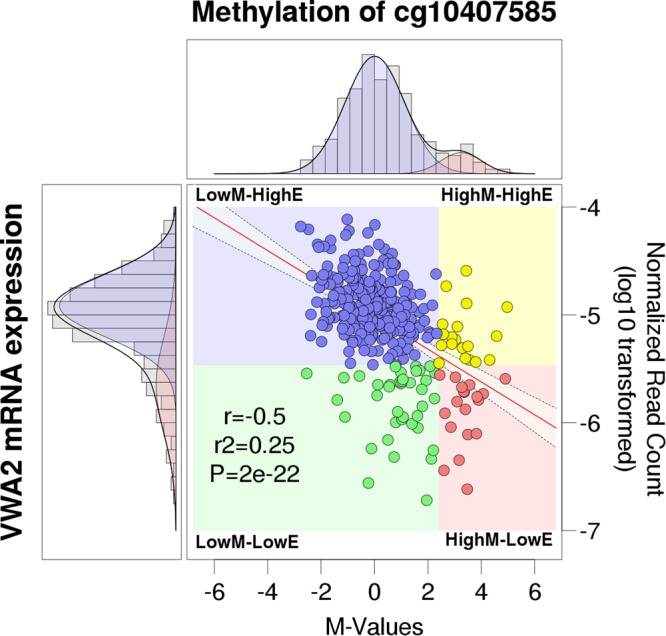
Correlation between methylation of probe cg10407585 and VWA2 mRNA expression in 348 CRC tumors from the TCGA. In the central dot plot, methylation is represented as M-values in the x-axis. M-values of -2 and 2 correspond to ß-values of 0.2 and 0.8, commonly considered thresholds for demethylation and full methylation, respectively. VWA2 mRNA expression is represented in the y-axis, as the log10 transformation of the normalized read counts. The regression line is in red, with the 95% confidence interval of the slope represented by the shaded area between the dashed lines. The Pearson’s product-moment correlation coefficient (r), the coefficient of determination (r2) and the P-value (P) after correction for multi-hypothesis testing are indicated. In the density graphs of the M-values (top) and log10-transformed normalized read counts (left), grey bars represent the histograms of the observed distributions. The solid black lines represent the expected density of fitted Gaussian mixture models (see Supplementary Fig. S5). For methylation (top), the model yielded a large group (89%, shaded in blue) with low to intermediate levels of methylation, and a smaller group (11%, shaded in pink) with high levels of methylation. For expression, the model yielded a large group (78%, shaded in blue) with higher expression and a small group (21%, shaded in pink) with lower expression. Combining both binary classifications, cases were divided into low methylation – high expression (LowM-HighE, 77.87%, blue dots), high methylation – high expression (HighM-HighE, 5.46%, yellow dots), low methylation – low expression (LowM-LowE, 11.21%, green dots) and high methylation – low expression (HighM-LowE, 5.46%, pink dots).
No statistically significant differences in clinicopathological characteristics (patient age, gender, race, weight, tumor location, mucinous phenotype and existence of synchronous cancers) were found between TCGA tumors with low vs high cg10407585 methylation, or with low vs high VWA2 expression (Supplementary Table ST4).
Treatment with AZA-2-deoxycytidine reactivates expression of VWA2 in cell lines
We analyzed VWA2 methylation by bisulfite sequencing in 7 colorectal cancer cell lines (Fig. 5). Paradoxically, in contrast with the initial observation where hypermethylation of the VWA2 CGI was never detected in primary tumors, this region was heavily methylated in 2 of the CRC cell lines, namely HT29 and HCT116. In SW48, the CGI was partially methylated, showing a similar pattern to that found in normal colonic tissues. In DLD1, hypomethylation was clearly detected in region 3. Finally, in SW480 and SW620, originated from a primary tumor and a lymph node metastasis from the same patient, the four analyzed regions were essentially hypomethylated.
Figure 5.
Methylation of the 5′-associated region of VWA2 in CRC cell lines. On top, a scheme of the region. Symbols and tracks identical to those in Fig. 1. At the bottom, bisulfite sequencing results. Analyses were performed in 4 separate PCRs. Every line represents and individually sequenced clone. Dots represent unmethylated (blue) or methylated (black) CpG sites. Primary cancer-derived cell lines are organized from higher (HT29) to lower (SW480) methylation levels. The lymph node-derived cell line SW620 is shown at the bottom.
The association between VWA2 DNA methylation and transcriptional expression was studied only in primary cancer derived cell lines, after excluding the lymph-node metastatic cell line SW620 (Fig. 6). The highest-expressing cell line was SW480, which also exhibited the lowest levels of methylation. Expression gradually declined with increasing methylation in DLD1, Colo205 and SW48, and reached the lowest values in the highly methylated lines HCT116 and HT29 that exhibited less than one thousand and ten thousand times lower levels than SW480, respectively, demonstrating a strong negative correlation between DNA methylation and gene expression (Spearman’s rank correlation rho = 1, P = 0.003). Upon 48 h treatment with 1 µM of the DNMTs inhibitor 5-AZA-2-deoxycytidine (AdC), VWA2 expression was greatly induced in HCT116 and HT29, and to a lower extent in SW48 and Colo205 (Fig. 6).
Figure 6.
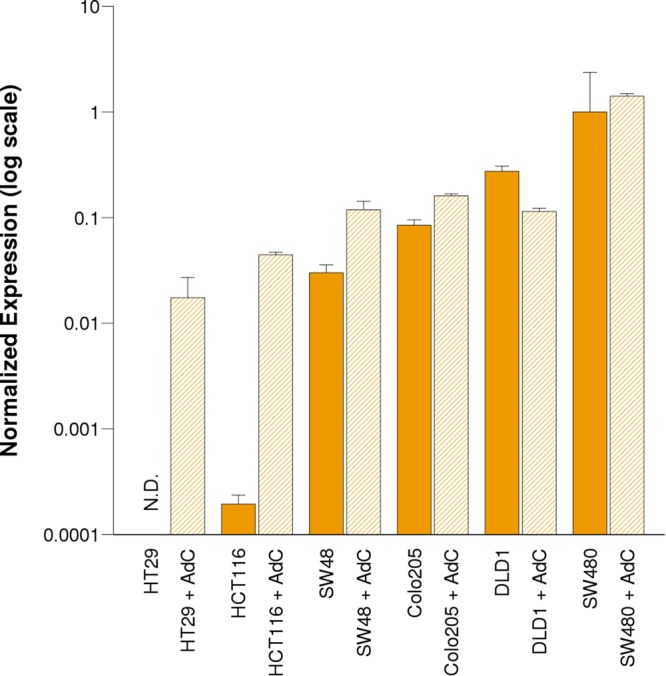
VWA2 trancriptional expression measured by qPCR in cell lines derived from primary CRC. Cells are ordered according to the methylation level in the VWA2 5′ region (Fig. 5), from more methylated (HT29) to less methylated (SW480). mRNA levels were normalized against the highest expressing cell line (SW480) using GAPDH and TPT1 as reference housekeeping genes. Bars indicate VWA2 mRNA levels after 48 h of treatment with DMSO (solid bars) or DMSO + 2-deoxy-AZA-cytidine 1 µM (AdC, dashed bars). Experiments were performed in triplicate. Error bars indicate the standard error. N.D.: mRNA not detected after 40 cycles of PCR.
Up-regulation of VWA2 associates with increased expression of WNT/Myc target genes
Using the RNAseq data from the COAD and READ datasets from the TCGA (20501 genes in 594 colorectal cancers), we calculated the correlation between VWA2 transcriptional levels and that of the remaining 20500 genes (Supplementary Table ST5). gene set enrichment analysis (GSEA) revealed that VWA2 expression correlated with several gene sets from the hallmark collection of the molecular signatures database (MSigDB, Supplementary Table ST6)18,19, most notably genes activated by WNT signaling (MSigDB gene set M5895) and Myc-target genes (MSigDB gene set M5928) (Fig. 7).
Figure 7.
Gene set enrichment analysis performed with GSEA on 20501 genes list sorted according to the correlation between their expression level and VWA2 expression in 594 CRC cancers from the TCGA. The two gen sets with strongest association were HALLMARK_WNT_BETA_CATENIN_SIGNALING (MutSigDB M5895, genes up-regulated by activation of WNT signaling through accumulation of beta catenin CTNNB1, left) and HALLMARK_MYC_TARGETS_V2 (MutSigDB M5928, A subgroup of genes regulated by MYC - version 2, right). A complete list of results is available in Supplementary Table ST6.
Moreover, somatic up-regulation of VWA2 was not accompanied by up-regulation of neighboring genes. Of the 55 genes within the 10 Mb region surrounding VWA2 locus, VWA2 exhibited the highest up-regulation in tumors (16.6 fold change compared with normal tissues, Supplementary Fig. S6). Two other genes, namely RPL13AP6 and HABP2, were also up-regulated but to a lower extent (4.1 and 8.9 fold change, respectively). The vast majority of the genes in that region did not exhibit significant changes (n = 38) or were down-regulated in tumors (n = 14). This observation suggested that VWA2 up-regulation is a targeted phenomenon rather than a co-lateral effect of copy number amplification targeting a neighboring gene.
In view of these results, and considering the relatively high correlation between VWA2 and MYC expression (r = 0.297, P = 1.4 × 10−7, among the top 1.3% correlated genes), we scanned the DNA sequence of VWA2 for putative Myc-binding motifs that could suggest a direct regulation mechanism20,21. Albeit VWA2 was not included among the MSigDB hallmark myc targets gene sets M5926 or M5928, nor reported among the 257 genes of the high Myc-affinity group in a comprehensive ChIP-Seq scan performed in 6 different human cell lines22, we found a perfect Myc binding motif (5′-tccCACGTGgca-3′, in uppercase the consensus E-box hexamer) located 120 bp downstream of the VWA2 TSS, within its promoter-associated CpG island. This motif complies with the typical characteristics of high-affinity E-boxes, i.e. perfect hexamer within an unmethylated CpG-rich sequence.
At the present time, ENCODE has generated c-myc ChIP-seq data for 9 different cell lines (K562, MCF-7, HeLa-S3, MCF10A, A549, GM12878, HepG2, NB4 and H1-hESC, see methods), albeit none of the 6 CRC lines included in our study. This data revealed a significant enrichment of c-myc at the E-box containing VWA2 DNA region in two cancer cell lines, MCF-7 (breast cancer) and HepG2 (hepatocellular carcinoma) and in the embryonic stem cells H1-hESC (Supplementary Fig. S7), supporting that c-myc can directly bind this DNA region in cells where MYC is highly expressed23.
Given the accumulation of indirect evidence suggestion a functional role of c-myc on the expression of VWA2, we tested this association by treating DLD1 and SW480 cell lines (both myc+ and exhibiting the highest expression level of VWA2, Fig. 6) with the c-myc inhibitor 10058-F4 for 48 h at three different concentrations24,25. The results revealed a significant reduction of VWA2 expression upon treatment with 100 µM 10058-F4 (Fig. 8), further supporting a functional link between c-myc and VWA2 up-regulation.
Figure 8.
VWA2 transcriptional levels in DLD1 (left) and SW480 (right) CRC cell lines, after 48 h treatment with the c-myc inhibitor 10058-F4 at different concentrations. Solid bars indicate control cells treated with the vehicle (DMSO). Dashed bars indicated the cells treated with vehicle + 25 µM, 50 µM and 100 µM 10058-F4. mRNA levels were normalized against the highest expressing cell line (SW480) using GAPDH and TPT1 as reference housekeeping genes. Experiments were performed in duplicate. Error bars indicate the standard error.
Expression of VWA2 in other cancer types
The analysis of VWA2 expression in normal and tumor tissues from 34 different cancer cohorts with RNAseq data available at the TCGA revealed that somatic over-expression of this gene is particularly strong and frequent in colon and rectal cancers. Other types of cancer exhibited the opposite trend, i.e. somatic downregulation of VWA2, in particular kidney cancers, lung squamous cell carcinoma and head and neck squamous cell carcinomas (Supplementary Table ST7 and Supplementary Fig. S8). Among the 15 most common cancers (as defined by the National Cancer Institute of the NIH, https://www.cancer.gov/types/common-cancers)26, colorectal cancer is clearly the one that exhibits the most dramatic somatic up-regulation of VWA2, both in frequency and magnitude (Fig. 9).
Figure 9.
VWA2 transcriptional levels in normal (yellow) and tumor (orange) tissues in the most common types of cancer from the TCGA datasets. P-values were calculated by Student’s t-test. Not enough data from normal DLBC and SKCM tissues was available to perform the statistical test (P = NA).
Discussion
VWA2 had been found to be over-expressed in the majority of colorectal tumors, including adenomas and carcinomas10,11. This gene has a CpG island encompassing its canonical transcriptional start site and its first non-coding exon. Based on the existence of a promoter-associated CGI, VWA2 would be susceptible to epigenetic regulation by DNA methylation. Our results show that this CpG island, however, did not undergo dramatic somatic methylation changes in primary CRCs, remaining mostly unmethylated in both normal and tumor samples (Fig. 1). However, the CpG island shore downstream of the first exon underwent clear somatic changes in methylation (Figs 1, 2 and Supplementary Fig. S2). DNA hypomethylation associated with an increase of H3K4me3 and a decrease of H3K27me3, consistent with transcriptional activation (Fig. 3).
The analyses both in our tumor collection (Fig. 2) and in the TCGA collection (Fig. S3) using Illumina HM450K arrays demonstrated that the 5′ region of the VWA2 CGI underwent negligible changes in methylation in CRC primary tumors, while the 3′ region of the CGI and, particularly, the south shore interrogated by probes cg22923514 (region 3) and cg10407585 (region 4) exhibited significant hypomethylation that correlates with transcriptional up-regulation (Fig. S4).
Our initial MS-AFLP analyses yielded an incidence of somatic hypomethylation much lower (17%) than the reported frequency of over-expression in primary cancers (80%)10. This apparent discrepancy was likely due to the very strict criterion that we employed to classify VWA2 hypomethylation using MS-AFLP (see methods), leading to a high probability of false negative error. Bisulfite sequencing revealed that demethylation of the VWA2 CGI shore was a gradual phenomenon spreading from the CGI downstream towards the PCR regions 3 and 4. The NotI site interrogated by MS-AFLP was located in the PCR region 3, where the differences between normal and tumor tissues were not as dramatic as in the downstream PCR region 4. That region is interrogated by the Illumina HM450K probe cg10407585, that showed very high sensitivity to detect somatic changes in methylation (Fig. 2 and Supplementary S3) and also the strongest correlation with VWA2 expression levels (Fig. 4 and Supplementary S4). Both our tumor collection and the TCGA dataset revealed the existence of two distinct groups of tumors according to the methylation levels of the probe cg10407585. The larger group, comprising around 80% of the tumors, exhibited low to intermediate methylation values (Fig. 4). This group of tumors was largely overlapping with the group of tumors with higher VWA2 expression. Classifying the tumors according to both methylation and expression revealed that the vast majority of the tumors (271/348, 78%) belong to the low-methylation and high-expression group. That analysis also revealed a small percentage of tumors (5.5%) that exhibited over-expression of VWA2 but not somatic DNA hypomethylation. Conversely, a small percentage of tumors (11%) exhibited somatic DNA hypomethylation but not transcriptional activation. This suggests that DNA hypomethylation and transcriptional activation, albeit strongly inter-related, might also occur independently. In line with this observation, our FFPE ChIP-Seq experiments showed that case 719 exhibited epigenetic remodeling consistent with transcriptional reactivation, but not somatic DNA demethylation (Fig. 3).
When we first identified VWA2 somatic hypomethylation using MS-AFLP, we found that it associated with patient age (Table 1). However, the methylation levels of the probe cg10407585 both in our dataset and the TCGA COAD + READ datasets did not associate with patient age (Supplementary Table ST4). This discrepancy might be explained, once again, by the extremely strict criterion applied to score the MS-AFLP results. The lack of association with age suggests that VWA2 hypomethylation is a targeted event rather than just a consequence of the age-related genomewide hypomethylation that takes place in essentially all dividing tissues13,27.
Expression of VWA2 in primary tumors correlated with expression c-Myc, and with that of Myc target genes, suggesting that VWA2 might be part of an oncogenic transcriptional program driven by c-Myc28–30. In line with this observation, we found a perfect E-box motif 120 bp downstream of the VWA2 TSS within its promoter-associated CpG island, suggesting that VWA2 could be an unreported direct target of Myc in CRC. The data from the ENCODE project revealed c-myc enrichment at this region in several MYC-expressing cell lines (Supplementary Fig. S7), with the enrichment peaks centered on the E-box motif located in the first exon of VWA2. In addition, treatment with the c-myc inhibitor 10058-F4 reduced the transcriptional levels of VWA2 in DLD1 and SW480 cells (Fig. 8). Both cell lines exhibit a strong up-regulation of MYC, which might explain the requirement of a relatively high concentration (100 µM) of 10058-F4 to induce transcriptional down-regulation of VWA2.
Paradoxically, HT29 and HCT116 cell lines exhibited strong hypermethylation and transcriptional silencing of VWA2 (Figs 5 and 6), essentially the opposite phenomenon to that observed in primary cancers. None of the primary tumors in our collection (n = 35) or in the TCGA collection (n = 352) exhibited hypermethylation of the VWA2 CGI. This apparently contradictory finding suggests that while VWA2 might play a pro-tumoral role in oncogenesis or during tumor progression, its function would not be required and perhaps even subjected to negative selection during in-vitro cell culturing, thereby leading to culture-induced epigenetic silencing. De novo methylation of CpG islands upon adaptation to cell culturing conditions is a long observed and common phenomenon31, calling for caution before extrapolating findings from cell lines to primary cancers. If the pro-tumoral effect of VWA2 is associated with the activation of an oncogenic transcriptional program driven by Myc, as suggested by the co-regulation analysis, it can be speculated that over-expression of VWA2 would become irrelevant for cancer cells once they become adapted to in vitro culture conditions. A previous study exploring epigenetic changes induced by cell culture in mouse embryonic fibroblasts (MEFs) revealed global loss of 5-hydroxymethylcytosine (5hmC, an intermediate of methyl-cytosine demethylation by an active mechanism) upon adaptation to culture conditions32. Notably, Vwa2 was one of the genes found to undergo loss of 5hmC. Whether this observation in mouse MEFs would be also applicable to human colorectal cancer cells is uncertain, considering the different nature of these cells, but it opens the interesting question regarding the mechanism (active or passive) responsible for the observed hypomethylation of VWA233.
AdC-induced DNA demethylation significantly increased VWA2 transcription in all studied CRC cancer cell lines except DLD1 and SW480 (Fig. 6), both with mostly hypomethylated region 3 where the NotI site is located, suggesting that hypomethylation of this region facilitates VWA2 transcription. Due to the genomewide effect of AdC, we cannot determine whether the pharmacological demethylation exerts a direct effect on VWA2 transcription, i.e. through demethylation of the VWA2 locus, relaxing the chromatin structure and facilitating the access of the transcriptional machinery, or indirect, i.e. through activation of a transcriptional factor in trans.
The pharmacological induction and repression experiments shown in Figs 6 and 8 were conducted using a QPCR primer combination targeting exons 8–10. Notably, a regulated ncRNA variant of VWA2 lacking exons 1 to 5 was originally reported in adult mouse kidney2. We confirmed that the up-regulated VWA2 mRNA also contained the initial coding exons, by analyzing both the AdC-induced transcriptional activation in HT29 and HCT116, and the down-regulation induced by 10058-F4 in SW480, using two additional sets of primers targeting exons 2–4 (Supplementary Fig. S9).
In conclusion, our results revealed the link between somatic DNA hypomethylation of the VWA2 CGI shore and the aberrant over-expression of this gene in primary colorectal cancers, exemplifying how epigenetic alterations taking place in the proximity of a promoter-associated CpG island may correlate with gene transcription even when the CpG island itself remains essentially unaltered34. Our results also unveiled an apparently paradoxical observation: VWA2 becomes over-expressed in primary CRCs but epigenetically repressed in some CRC cell lines, suggesting that the putative pro-tumoral effect of VWA2 is not required (and perhaps even detrimental) for CRC cells growing in culture. In addition, we found compelling evidence that VWA2 is one of the targets of a transcriptional program regulated by Myc. Finally, our study revealed that over-expression of VWA2 is virtually exclusive of colorectal cancers (Fig. 8) which, together with fact that it has been also found over-expressed in adenomas10, reinforces its potential as a highly sensitive and specific biomarker for early detection of CRC11,35.
Methods
Tumor samples and colorectal cancer cell lines
Eighty-one primary colon cancers with matched normal tissue were obtained as frozen specimens and FFPE samples from the Cooperative Human Tissue Network (CHTN, https://www.chtn.org/). The CHTN is a unique resource supported by the National Cancer Institute of the USA, providing human tissues and fluids from routine procedures to investigators who utilize human biospecimens in their research. Informed consent was obtained and managed by the CHTN at the time of sample collection, following US regulations and the guidelines of the Declaration of Helsinki36. Our research group has been collecting cancer samples from the CHTN for over 20 years, when based at the Sanford-Burnham-Prebys Medical Discovery Institute, formerly Sanford-Burnham Medical Research Institute (SBMRI). Approval to collect samples, extract DNA and perform analyses was obtained at the time from the Institutional Review Board (IRB) of the SBMRI. Part of the extracted DNA collection has been transferred to our laboratory at the IGTP, Barcelona, Spain. Additional approval was obtained from the IRB of the IGTP to further analyze the DNA samples employed in this study. Seven colorectal cancer cell lines were obtained from the ATCC: HT29 (ATCC HTB-38), HCT116 (ATCC CCL-247), SW48 (ATCC CCL-231), Colo205 (ATCC CCL-222), DLD1 (ATCC CCL-221), SW480 (ATCC CCL-228), SW620 (ATCC CCL-227).
Cell culture conditions
Cells were cultured in DMEM-F12 (Life Technologies) supplemented with fetal bovine serum 10% (v/v), antibiotics, and antimycotics on 100 mm culture dishes in a 37 °C incubator with 5% CO2. Unless otherwise indicated, cells were grown until reaching 80–90% confluency before collection. To induce DNA demethylation, 5-aza-2′-deoxycytidine (5AdC, Sigma-Aldrich, CatNo. A3656) was added to the culture media at a final concentration of 1 µM, from a 500 µM working solution. Myc inhibitor 10058-F4 was purchased from Sigma-Aldrich (CatNo F3680). Stocks were prepared at 2.5 mM, 5 mM and 10 mM in DMSO. Final concentration was 2.5 µM, 5 µM and 10 µM. Controls were subjected to the same incubation conditions but adding only the vehicle at the appropriate volume.
Methylation-sensitive amplified fragment length polymorphism (MS-AFLP)
MS-AFLP was performed as described previously. Briefly, 1 µg of genomic DNA was digested overnight with 5 units of methylation-sensitive NotI (Roche, Indianapolis, IN) and 2 units of methylation-insensitive MseI (NE Biolabs, Beverly, MA) at 37 °C. Two pairs of oligonucleotides were annealed overnight at 37 °C to generate NotI and MseI specific adaptors. The digested DNA was ligated to 1.25 ml each of 5 pmol/ml NotI and 50 pmol/ml MseI adaptor using 1 unit of T4 DNA ligase (Roche) overnight at 16 °C. A primer complementary to the NotI adaptor (NotI primer) was labeled at the 5′ end using 32P-γ-ATP and T4 polynucleotide kinase (Promega, Madison, WI). The adaptor-ligated template DNA was PCR amplified using 32P-labeled NotI and MseI-C primers. A total of 20 µl of PCR mixture consisted of 6 ng of 32P-labeled NotI primer, 30 ng of MseI-C primer, 0.4 mM dNTP, and 1 unit of AmpliTaq DNA polymerase (Perkin-Elmer, Foster City, CA). Two different amounts of template DNA (2 ng and 4 ng) were used to confirm the reproducibility of the results. The PCR started at 72 °C for 30 s and 94 °C for 30 s, then was followed by 35 cycles of 94 °C for 30 s, 52 °C for 30 s, and 72 °C for 2 min. The final extension was performed for 10 min at 72 °C. Each PCR sample was electrophoresed on a denaturing gel (Sequagel-6, National Diagnostics, Atlanta, GA) after heat denaturing. The gel was dried and exposed to an X-ray film. Primer sequences are detailed in Supplementary Table ST1.
Scoring of methylation alterations in tumors by MS-AFLP
Independent DNA fingerprints were run on acrylamide gels in duplicate or triplicate. Scoring of quantitative changes between normal and tumor DNA was made by visual inspection independently by three researchers, as described previously14,37. Somatic alterations were scored on bands with consistent pattern among normal tissues, with clear changes in intensity in tumor samples and called by at least two of the three researchers.
COBRA and bisulfite genomic sequencing
Genomic DNA was treated with sodium bisulfite using EZ DNA Methylation Kit (Zymo Research, Orange, CA). Four different semi-nested PCRs were designed to cover a total of 1.2 kB, including the CpG island upstream of Exon 1 and the location of the band previously identified by MS-AFLP. Primers are described on Supplementary Table ST1. For COBRA, after amplification, the PCR products were subjected to digestion with the restriction endonuclease BstUI (New England Biolabs, Ipswich, MA) or its isoschizomer Bsh12361 (Thermofisher Scientific), and subsequently resolved on agarose gels. For bisulfite genomic sequencing the PCR products were cloned into StrataClone SoloPack Competent Cells using StrataClone PCR Cloning Kit (Agilent, Life Technologies, CA). Cells were cultured on LB plates containing Kanamycin 30 µg/ml and XGal 20 µg/ml. Plasmids from white positive colonies were isolated using Nucleospin Plasmid EasyPure (Macherey-Nagel GmbH & Co. KG, Dueren, Germany). Sequencing of the cloned PCR products was performed by GATC BiotechAG (Germany) using T3 universal primer.
Methylation arrays
Genomewide methylation was assayed using Illumina HM450K Methylation arrays, and processed using RnBeads software16. In most figures, methylation was generally represented in the more intuitive ß-value units, which range between 0 (unmethylated cytosine) and 1 (methylated cytosine), but statistical analyses were performed on the M-values since they exhibit lower heterocedasticity than ß-values38.
Chromatin immunoprecipitation
Chromatin was prepared from using ChIP-IT® FFPE from Active Motif and subsequently subjected to immunoprecipitation with H3K4me3 (active transcription mark) and H3K27me3 (inhibitory mark) antibodies, following the manufacturer protocol. After reverse cross-linking, immunoprecipitated DNA was used to prepare genomic libraries that were sequenced in an Illumina NGS sequencer following standard procedures.
Gene expression analyses
To analyze VWA2 mRNA levels, total RNA was extracted using Maxwell® 16 LEV simplyRNA Purification Kit (Promega) and the Maxwell® 16 Instrument MX3031 (Promega, CatN° AS2000) following the supplier protocol. The purified RNA was used as template to synthesize cDNA using Superscript-II reverse transcriptase (Invitrogen, Life Technologies) with random hexamers for priming. We designed three primer pairs to analyze VWA2 expression (Supplementary Table ST1), amplifying exons 8–10 (PB66 + PB67, 150 bp amplicon size) or exons 2–4 (PB271 + PB272, 203 bp amplicon size, and PB273 + PB274, 198 bp amplicon size). The results shown in Figs 6 and 8 correspond to the PB66 + PB67 primer pair, targeting exons 8–10. The results obtained with PB271 + PB272 and PB273 + PB274 are shown in Supplementary Fig. 8. Amplification was quantified in real time using SYBR-Green Master Mix in a Lightcycler LC480-II System (Roche, CA). After 40 cycles, the specificity of the amplification was verified by melting curve analysis, and the amplicon size was subsequently confirmed by electrophoresis in 2% (w/v) agarose gels. All reactions were performed in duplicate. Expression levels were calculated using the 2−∆∆Ct method combining both GAPDH and TPT1 as normalization genes. In all PCR reactions, experimentally determined amplification efficiency was very close to 2 within the range of concentrations assayed. A GFF3 file with the exact location of the primers and relevant sequence features is provided as Supplementary material (Features.gff3).
Data from the The Cancer Genome Atlas (TCGA)
Clinical DNA methylation and mRNA expression data from TCGA CRC dataset (COAD + READ datasets)17 was downloaded from the International Cancer Genome Consortium (ICGC) website39. For the comparative analysis of VWA2 expression in other cancer types, log2 RSEM data (RNA-Seq by Expectation Maximization)40 was obtained from the Broad Institute GDAC Firehose server (http://gdac.broadinstitute.org/) using the FirebrowseR R package41.
Data from the ENCODE project
c-myc ChIP-seq data was obtained from the ENCODE project23 and visualized on the UCSC genome browser42,43. Twenty two ChIP-seq experiments were available, performed on 9 cell lines: A549 (lung carcinoma, accession ENCSR000DYC), GM12878 (lymphoblastoid, accession ENCSR000DKU), H1-hESC (human embryonic stem cell, accession ENCSR000EBY and ENCSR000DLI), HELA S3 (cervix adenocarcinoma, accession ENCSR000DLN and ENCSR000EZD), HepG2 (hepatocellular carcinoma, accession ENCSR000DLR), K562 (myeloid leukemia, accession ENCSR000DLZ, ENCSR000EZV, ENCSR000EGJ, ENCSR000EZU, ENCSR000EGS, ENCSR000FAZ and ENCSR000FAG), MCF10A (mammary epithelial cells, accession ENCSR000DOM and ENCSR000DOS), MCF-7 (breast cancer, accession ENCSR000DMM, ENCSR000DMQ, ENCSR000DMP and ENCSR000DMJ), and NB4 (mouse neuroblastoma, accession ENCSR000EHR).
Statistical analyses
Statistical analyses were performed in R environment for statistical computing44, using Rstudio integrated development environment45. Contingency tables were analyzed using Fisher’s exact test or chi-squared test. Continuous variables were first tested for normality using Shapiro-Wilk normality test. If the variable exhibited a normal distribution, Student’s t-test was applied. Otherwise, Wilcoxon signed-rank sum test was applied. In this work we have employed the following packages, available from the CRAN or Bioconductor46: mixtools47, Biostrings48, exactRankTests49, FirebrowseR41 and biomaRt50,51. Gene set enrichment analysis was performed using GSEA v2.0 from the Broad Institute52, applying the GSEA preranked method with default parameters on the list of genes ranked according to their correlation with VWA2 expression.
Electronic supplementary material
Acknowledgements
We thank Dr. Manuel Perucho for his support and insightful discussions. This work was supported by the Spanish Ministry of Health, Plan Nacional de I + D + I, Plan Estatal de I + D + I, ISCIII, FEDER, FIS PI12/00511 and FIS PI15/01763 to M. Perucho. We also acknowledge the TCGA and ENCODE Consortiums for generating and sharing genomic data employed in this work. We are thankful for the ENCODE ChIP-seq data generated in the laboratories of Vishwanath Iyer, UTA, Michael Snyder, Standford, Sherman Weissman, Yale, and Kevin Struhl, HMS.
Author Contributions
VWA2 methylation analysis: B.G., F.F.d.C. and S.A. VWA2 expression analysis: B.G., F.F.d.C. and S.A. FFPE ChIP-Seq: J.K.S. Statistical and computational analysis: A.A. and S.A. Design and supervision: B.G. and S.A. Preparation of the manuscript: B.G., A.A. and S.A.
Competing Interests
The authors declare no competing interests.
Footnotes
Electronic supplementary material
Supplementary information accompanies this paper at 10.1038/s41598-018-29378-7.
Publisher's note: Springer Nature remains neutral with regard to jurisdictional claims in published maps and institutional affiliations.
References
- 1.Whittaker CA, Hynes RO. Distribution and evolution of von Willebrand/integrin A domains: widely dispersed domains with roles in cell adhesion and elsewhere. Mol Biol Cell. 2002;13:3369–3387. doi: 10.1091/mbc.e02-05-0259. [DOI] [PMC free article] [PubMed] [Google Scholar]
- 2.Sengle G, Kobbe B, Morgelin M, Paulsson M, Wagener R. Identification and characterization of AMACO, a new member of the von Willebrand factor A-like domain protein superfamily with a regulated expression in the kidney. J Biol Chem. 2003;278:50240–50249. doi: 10.1074/jbc.M307794200. [DOI] [PubMed] [Google Scholar]
- 3.Gebauer JM, Muller S, Hanisch FG, Paulsson M, Wagener R. O-glucosylation and O-fucosylation occur together in close proximity on the first epidermal growth factor repeat of AMACO (VWA2 protein) J Biol Chem. 2008;283:17846–17854. doi: 10.1074/jbc.M704820200. [DOI] [PubMed] [Google Scholar]
- 4.Gebauer JM, et al. Mouse AMACO, a kidney and skin basement membrane associated molecule that mediates RGD-dependent cell attachment. Matrix Biol. 2009;28:456–462. doi: 10.1016/j.matbio.2009.07.006. [DOI] [PubMed] [Google Scholar]
- 5.Ruoslahti E. RGD and other recognition sequences for integrins. Annu Rev Cell Dev Biol. 1996;12:697–715. doi: 10.1146/annurev.cellbio.12.1.697. [DOI] [PubMed] [Google Scholar]
- 6.Gebauer JM, Karlsen KR, Neiss WF, Paulsson M, Wagener R. Expression of the AMACO (VWA2 protein) ortholog in zebrafish. Gene Expr Patterns. 2010;10:53–59. doi: 10.1016/j.gep.2009.10.005. [DOI] [PubMed] [Google Scholar]
- 7.Richardson RJ, et al. AMACO is a component of the basement membrane-associated Fraser complex. J Invest Dermatol. 2014;134:1313–1322. doi: 10.1038/jid.2013.492. [DOI] [PMC free article] [PubMed] [Google Scholar]
- 8.Forbes SA, et al. COSMIC: somatic cancer genetics at high-resolution. Nucleic Acids Res. 2017;45:D777–D783. doi: 10.1093/nar/gkw1121. [DOI] [PMC free article] [PubMed] [Google Scholar]
- 9.Hoff AM, et al. Novel RNA variants in colorectal cancers. Oncotarget. 2015;6:36587–36602. doi: 10.18632/oncotarget.5500. [DOI] [PMC free article] [PubMed] [Google Scholar]
- 10.Xin B, et al. Colon cancer secreted protein-2 (CCSP-2), a novel candidate serological marker of colon neoplasia. Oncogene. 2005;24:724–731. doi: 10.1038/sj.onc.1208134. [DOI] [PubMed] [Google Scholar]
- 11.Kim J, et al. Molecular Imaging of Colorectal Tumors by Targeting Colon Cancer Secreted Protein-2 (CCSP-2) Neoplasia. 2017;19:805–816. doi: 10.1016/j.neo.2017.07.003. [DOI] [PMC free article] [PubMed] [Google Scholar]
- 12.Samuelsson JK, Alonso S, Yamamoto F, Perucho M. DNA fingerprinting techniques for the analysis of genetic and epigenetic alterations in colorectal cancer. Mutat Res. 2010;693:61–76. doi: 10.1016/j.mrfmmm.2010.08.010. [DOI] [PMC free article] [PubMed] [Google Scholar]
- 13.Suzuki K, et al. Global DNA demethylation in gastrointestinal cancer is age dependent and precedes genomic damage. Cancer Cell. 2006;9:199–207. doi: 10.1016/j.ccr.2006.02.016. [DOI] [PubMed] [Google Scholar]
- 14.Yamamoto F, et al. Notl-Msell methylation-sensitive amplied fragment length polymorhism for DNA methylation analysis of human cancers. Electrophoresis. 2001;22:1946–1956. doi: 10.1002/1522-2683(200106)22:10<1946::AID-ELPS1946>3.0.CO;2-Y. [DOI] [PubMed] [Google Scholar]
- 15.Eads CA, Laird PW. Combined bisulfite restriction analysis (COBRA) Methods Mol Biol. 2002;200:71–85. doi: 10.1385/1-59259-182-5:071. [DOI] [PubMed] [Google Scholar]
- 16.Assenov Y, et al. Comprehensive analysis of DNA methylation data with RnBeads. Nat Methods. 2014;11:1138–1140. doi: 10.1038/nmeth.3115. [DOI] [PMC free article] [PubMed] [Google Scholar]
- 17.Cancer Genome Atlas, N. Comprehensive molecular characterization of human colon and rectal cancer. Nature487, 330–337, 10.1038/nature11252 (2012). [DOI] [PMC free article] [PubMed]
- 18.Liberzon A, et al. The Molecular Signatures Database (MSigDB) hallmark gene set collection. Cell Syst. 2015;1:417–425. doi: 10.1016/j.cels.2015.12.004. [DOI] [PMC free article] [PubMed] [Google Scholar]
- 19.Liberzon A, et al. Molecular signatures database (MSigDB) 3.0. Bioinformatics. 2011;27:1739–1740. doi: 10.1093/bioinformatics/btr260. [DOI] [PMC free article] [PubMed] [Google Scholar]
- 20.Prendergast GC, Lawe D, Ziff EB. Association of Myn, the murine homolog of max, with c-Myc stimulates methylation-sensitive DNA binding and ras cotransformation. Cell. 1991;65:395–407. doi: 10.1016/0092-8674(91)90457-A. [DOI] [PubMed] [Google Scholar]
- 21.Blackwood EM, Eisenman RN. Max: a helix-loop-helix zipper protein that forms a sequence-specific DNA-binding complex with Myc. Science. 1991;251:1211–1217. doi: 10.1126/science.2006410. [DOI] [PubMed] [Google Scholar]
- 22.Fernandez PC, et al. Genomic targets of the human c-Myc protein. Genes Dev. 2003;17:1115–1129. doi: 10.1101/gad.1067003. [DOI] [PMC free article] [PubMed] [Google Scholar]
- 23.Encode Project Consortium. An integrated encyclopedia of DNA elements in the human genome. Nature489, 57–74, 10.1038/nature11247 (2012). [DOI] [PMC free article] [PubMed]
- 24.Wang H, et al. Improved low molecular weight Myc-Max inhibitors. Mol Cancer Ther. 2007;6:2399–2408. doi: 10.1158/1535-7163.MCT-07-0005. [DOI] [PubMed] [Google Scholar]
- 25.Berg T, et al. Small-molecule antagonists of Myc/Max dimerization inhibit Myc-induced transformation of chicken embryo fibroblasts. Proc Natl Acad Sci USA. 2002;99:3830–3835. doi: 10.1073/pnas.062036999. [DOI] [PMC free article] [PubMed] [Google Scholar]
- 26.Siegel RL, Miller KD, Jemal A. Cancer Statistics, 2017. CA Cancer J Clin. 2017;67:7–30. doi: 10.3322/caac.21387. [DOI] [PubMed] [Google Scholar]
- 27.Heyn H, et al. Distinct DNA methylomes of newborns and centenarians. Proc Natl Acad Sci USA. 2012;109:10522–10527. doi: 10.1073/pnas.1120658109. [DOI] [PMC free article] [PubMed] [Google Scholar]
- 28.Baudino TA, et al. c-Myc is essential for vasculogenesis and angiogenesis during development and tumor progression. Genes Dev. 2002;16:2530–2543. doi: 10.1101/gad.1024602. [DOI] [PMC free article] [PubMed] [Google Scholar]
- 29.Garte SJ. The c-myc oncogene in tumor progression. Crit Rev Oncog. 1993;4:435–449. [PubMed] [Google Scholar]
- 30.Myant K, Sansom OJ. Wnt/Myc interactions in intestinal cancer: partners in crime. Exp Cell Res. 2011;317:2725–2731. doi: 10.1016/j.yexcr.2011.08.001. [DOI] [PubMed] [Google Scholar]
- 31.Antequera F, Boyes J, Bird A. High levels of de novo methylation and altered chromatin structure at CpG islands in cell lines. Cell. 1990;62:503–514. doi: 10.1016/0092-8674(90)90015-7. [DOI] [PubMed] [Google Scholar]
- 32.Nestor CE, et al. Rapid reprogramming of epigenetic and transcriptional profiles in mammalian culture systems. Genome Biol. 2015;16:11. doi: 10.1186/s13059-014-0576-y. [DOI] [PMC free article] [PubMed] [Google Scholar]
- 33.Bhutani N, Burns DM, Blau HM. DNA demethylation dynamics. Cell. 2011;146:866–872. doi: 10.1016/j.cell.2011.08.042. [DOI] [PMC free article] [PubMed] [Google Scholar]
- 34.Irizarry RA, et al. The human colon cancer methylome shows similar hypo- and hypermethylation at conserved tissue-specific CpG island shores. Nat Genet. 2009;41:178–186. doi: 10.1038/ng.298. [DOI] [PMC free article] [PubMed] [Google Scholar]
- 35.Berretta M, et al. Serum and tissue markers in colorectal cancer: State of art. Crit Rev Oncol Hematol. 2017;111:103–116. doi: 10.1016/j.critrevonc.2017.01.007. [DOI] [PubMed] [Google Scholar]
- 36.World Medical, A. World Medical Association Declaration of Helsinki: ethical principles for medical research involving human subjects. JAMA310, 2191–2194, 10.1001/jama.2013.281053 (2013). [DOI] [PubMed]
- 37.Yamashita K, Dai T, Dai Y, Yamamoto F, Perucho M. Genetics supersedes epigenetics in colon cancer phenotype. Cancer Cell. 2003;4:121–131. doi: 10.1016/S1535-6108(03)00190-9. [DOI] [PubMed] [Google Scholar]
- 38.Du P, et al. Comparison of Beta-value and M-value methods for quantifying methylation levels by microarray analysis. BMC Bioinformatics. 2010;11:587. doi: 10.1186/1471-2105-11-587. [DOI] [PMC free article] [PubMed] [Google Scholar]
- 39.Zhang J, et al. International Cancer Genome Consortium Data Portal–a one-stop shop for cancer genomics data. Database (Oxford) 2011;2011:bar026. doi: 10.1093/database/bar026. [DOI] [PMC free article] [PubMed] [Google Scholar]
- 40.Li B, Dewey CN. RSEM: accurate transcript quantification from RNA-Seq data with or without a reference genome. BMC Bioinformatics. 2011;12:323. doi: 10.1186/1471-2105-12-323. [DOI] [PMC free article] [PubMed] [Google Scholar]
- 41.Deng, M., Bragelmann, J., Kryukov, I., Saraiva-Agostinho, N. & Perner, S. FirebrowseR: an R client to the Broad Institute’s Firehose Pipeline. Database (Oxford) 2017, 10.1093/database/baw160 (2017). [DOI] [PMC free article] [PubMed]
- 42.Raney BJ, et al. Track data hubs enable visualization of user-defined genome-wide annotations on the UCSC Genome Browser. Bioinformatics. 2014;30:1003–1005. doi: 10.1093/bioinformatics/btt637. [DOI] [PMC free article] [PubMed] [Google Scholar]
- 43.Kent WJ, et al. The human genome browser at UCSC. Genome Res. 2002;12:996–1006. doi: 10.1101/gr.229102. [DOI] [PMC free article] [PubMed] [Google Scholar]
- 44.R Core Team. R: A language and environment for statistical computing. R Foundation for Statistical Computing, Vienna, Austria. https://www.R-project.org/ (2018).
- 45.RStudio Team. RStudio: Integrated Development for R. RStudio, Inc., Boston, MA, http://www.rstudio.com/ (2015).
- 46.Huber W, et al. Orchestrating high-throughput genomic analysis with Bioconductor. Nat Methods. 2015;12:115–121. doi: 10.1038/nmeth.3252. [DOI] [PMC free article] [PubMed] [Google Scholar]
- 47.Benaglia T, Chauveau D, Hunter DR, Young D. mixtools: An R Package for Analyzing Finite Mixture Models. Journal of Statistical Software. 2009;32:1–29. doi: 10.18637/jss.v032.i06. [DOI] [Google Scholar]
- 48.Pagès, H., Aboyoun, P., Gentleman, R. & DebRoy, S. Biostrings: Efficient manipulation of biological strings. R package version 2.48.0. (2018).
- 49.Hothorn, T. & Hornik, K. exactRankTests: Exact Distributions for Rank and Permutation Tests. R package version 0.8-29 (2017).
- 50.Durinck S, et al. BioMart and Bioconductor: a powerful link between biological databases and microarray data analysis. Bioinformatics. 2005;21:3439–3440. doi: 10.1093/bioinformatics/bti525. [DOI] [PubMed] [Google Scholar]
- 51.Durinck S, Spellman PT, Birney E, Huber W. Mapping identifiers for the integration of genomic datasets with the R/Bioconductor package biomaRt. Nat Protoc. 2009;4:1184–1191. doi: 10.1038/nprot.2009.97. [DOI] [PMC free article] [PubMed] [Google Scholar]
- 52.Subramanian A, et al. Gene set enrichment analysis: a knowledge-based approach for interpreting genome-wide expression profiles. Proc Natl Acad Sci USA. 2005;102:15545–15550. doi: 10.1073/pnas.0506580102. [DOI] [PMC free article] [PubMed] [Google Scholar]
Associated Data
This section collects any data citations, data availability statements, or supplementary materials included in this article.



